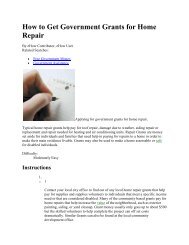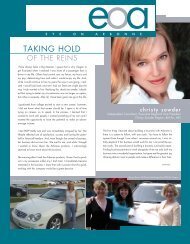Rats and Mice Introduction - Fairfax County Government
Rats and Mice Introduction - Fairfax County Government
Rats and Mice Introduction - Fairfax County Government
Create successful ePaper yourself
Turn your PDF publications into a flip-book with our unique Google optimized e-Paper software.
HEALTH<br />
HAZARDS<br />
from Rodents<br />
✔ Rodents contaminate food <strong>and</strong> can<br />
make people sick.<br />
✔ Rodents leave urine <strong>and</strong> fecal droppings<br />
wherever they travel, feed or nest.<br />
✔ More than 200 germs can be<br />
transmitted by rodents in their saliva,<br />
fecal droppings or urine.<br />
✔ A protein in rodent urine can cause<br />
allergic reactions in some people.<br />
✔ Rodents can cause house fires by<br />
gnawing on wires.<br />
✔ Baby rodents mature in 2-5 months<br />
<strong>and</strong> can produce up to six litters a<br />
year. A pair of rats <strong>and</strong> their offspring<br />
could multiply to 278 rats in one year!<br />
For more information or to arrange a rodent<br />
inspection of a home <strong>and</strong> yard, contact:<br />
FAIRFAX COUNTY HEALTH DEPARTMENT<br />
Division of Environmental Health<br />
Community Health <strong>and</strong> Safety Section<br />
10777 Main Street • <strong>Fairfax</strong>, VA 22030<br />
703-246-2300 • TTY 703-591-6435<br />
www.fairfaxcounty.gov/hd<br />
This document can be made available in an<br />
alternative format upon request. Please call<br />
703-246-2300, TTY 703-591-6435. Allow seven<br />
working days for preparation of the material.<br />
A <strong>Fairfax</strong> <strong>County</strong>, Va., publication<br />
Rev. June, 2006<br />
How to<br />
Identify <strong>and</strong><br />
Control<br />
MICE<br />
RATS<br />
<strong>and</strong><br />
FAIRFAX COUNTY<br />
HEALTH DEPARTMENT<br />
Division of Environmental Health<br />
Community Health <strong>and</strong> Safety Section<br />
RATS <strong>and</strong> MICE: An <strong>Introduction</strong><br />
<strong>Rats</strong> <strong>and</strong> mice are rodents that are commonly found living near people. They can be very<br />
destructive to homes, <strong>and</strong> can carry germs that make people sick. They often make their<br />
nests in <strong>and</strong> around people’s homes <strong>and</strong> office buildings.<br />
The most common rodents encountered by residents in <strong>Fairfax</strong> <strong>County</strong> are the Norway rat <strong>and</strong> the<br />
house mouse. Both of these rodents are very good at jumping, climbing, swimming, gnawing <strong>and</strong><br />
squeezing through very small spaces.<br />
Common<br />
(Norway) RAT<br />
The Norway rat digs <strong>and</strong><br />
travels through burrows, <strong>and</strong> will<br />
nest up to 150 feet from its food supply. It can<br />
make a nest in your home by gnawing holes in<br />
sheds <strong>and</strong> walls, etc., or squeezing through<br />
cracks <strong>and</strong> crevices in foundations, vents, etc.<br />
FACT: <strong>Rats</strong> can squeeze through spaces as<br />
small as a quarter!<br />
<strong>Rats</strong> <strong>and</strong> mice often make their<br />
nests in <strong>and</strong> around people’s<br />
homes <strong>and</strong> office buildings.<br />
Rodents are not picky about<br />
economic level or social status. If<br />
your home or building can provide<br />
shelter <strong>and</strong> a food source, you are<br />
inviting rats <strong>and</strong> mice to move in!<br />
How Do Rodents Get In?<br />
<strong>Rats</strong> <strong>and</strong> mice can crawl through<br />
very small spaces (under doors,<br />
into crevices, etc.) <strong>and</strong> when they<br />
can’t fit, then they simply gnaw<br />
<strong>and</strong> chew their way through.<br />
House MOUSE<br />
The house mouse usually makes<br />
a nest in stored materials indoors, but<br />
can also live outside, burrowing in areas around<br />
fields <strong>and</strong> lawns. <strong>Mice</strong> often become a problem<br />
in the fall when they enter homes to seek<br />
warmth. <strong>Mice</strong> tend to nest only 10 to 30 feet<br />
from their food supply.<br />
FACT: <strong>Mice</strong> can squeeze through spaces as<br />
small as a dime!<br />
Is Your Home Open to RATS <strong>and</strong> MICE?<br />
Common Entry-Ways<br />
for Rodents:<br />
✔<br />
✔<br />
✔<br />
✔<br />
✔<br />
✔<br />
✔<br />
gaps under doors<br />
pipe <strong>and</strong> wire chases<br />
cracks in foundations<br />
crawl space doors <strong>and</strong> vents<br />
vents or other holes without<br />
screens<br />
holes that have been chewed<br />
in plastic, wood, drywall<br />
holes that have been dug in<br />
the dirt or grass
How to Know if You<br />
Have RATS <strong>and</strong> MICE<br />
The most common signs of rats <strong>and</strong> mice<br />
are the evidence they leave behind, such as<br />
burrows, fecal droppings, tracks, chewed out<br />
holes in walls, chewed wires, urine stains <strong>and</strong><br />
nesting materials. Rodents are more likely to<br />
be seen or heard shortly after dark <strong>and</strong> in the<br />
early morning.<br />
The holes that rats chew in<br />
walls tend to be the size of<br />
a tennis ball (about 2" to 3"<br />
diameter)<br />
Rat fecal dropping<br />
shown actual size<br />
Mouse fecal dropping<br />
shown actual size<br />
Rodent Burrows<br />
Rodents use burrows to move from place<br />
to place. Burrows are typically found around<br />
concrete slabs <strong>and</strong> building foundations, under<br />
materials stored outdoors, <strong>and</strong> along fence rows.<br />
An active burrow entrance is usually seen as a<br />
hole in the ground, clear of<br />
leaves <strong>and</strong> debris.<br />
Active burrow runways are<br />
often clean <strong>and</strong> smooth,<br />
<strong>and</strong> frequently follow along<br />
a wall or fence.<br />
To find out if the burrow is active, loosely fill<br />
the opening of the hole with dirt. If a rodent<br />
is using that burrow, the hole will reappear.<br />
Rodents cannot be eliminated by blocking their<br />
burrows. They can simply dig another burrow.<br />
To control rodents, you MUST remove their food,<br />
shelter <strong>and</strong> entry points to your home or other<br />
buildings.<br />
Clean Up — Eliminate Food Sources<br />
Remove all rodent food.<br />
Trash <strong>and</strong> garbage should<br />
be contained in a rodentproof<br />
container, such as a<br />
trash can with a tight-locking<br />
lid. Trash cans <strong>and</strong> dumpsters<br />
should be cleaned regularly<br />
<strong>and</strong> their doors <strong>and</strong>/or lids<br />
should close tightly. Prevent<br />
bird seed from falling to the<br />
ground. Piles of wood, furniture <strong>and</strong> other yard<br />
debris should be removed. Grass should be cut<br />
low to the ground. Plants, bushes <strong>and</strong> branches<br />
should be trimmed away from the home or<br />
building. Pet waste should always be picked<br />
up <strong>and</strong> disposed properly.<br />
Garbage is an all-you-can-eat buffet<br />
for rodents<br />
How to CONTROL Rodents<br />
trash <strong>and</strong> garbage in<br />
plastic bags<br />
spilled or discarded food<br />
kitchen scraps<br />
pet food<br />
Rodent Proof Your Home<br />
<strong>and</strong> Buildings<br />
Holes larger than a dime, <strong>and</strong> cracks larger than<br />
the diameter of a pencil, should be sealed to<br />
prevent rodents from entering your home or other<br />
buildings. The gaps around pipe <strong>and</strong> wire chases<br />
should also be sealed. All doors, including the<br />
garage door, should have weather stripping. Tight<br />
fitting crawl space doors <strong>and</strong> vent covers should<br />
be in good repair. Check periodically around your<br />
home <strong>and</strong> other buildings to correct problem areas.<br />
Sealants that are strong<br />
<strong>and</strong> durable should be<br />
used.<br />
✔ steel wool<br />
✔ putty<br />
✔ copper stuffing<br />
✔ exp<strong>and</strong>able foam<br />
✔ cement<br />
WHAT RODENTS EAT<br />
Gap around hose<br />
Gap sealed with<br />
metal plate<br />
pet feces<br />
flower bulbs <strong>and</strong> seeds<br />
bird seed spilled on the ground<br />
food from low-hanging feeders<br />
ELIMINATE Rodents<br />
by Trapping or Baiting<br />
Trapping (recommended for indoors)<br />
Trapping is the recommended method for<br />
rodent control inside a structure. Many varieties<br />
of traps are available. Snap traps <strong>and</strong> glue<br />
boards are best used when just a few rodents<br />
are present. Catch traps for multiple rodents<br />
are best for larger numbers of rodents. All<br />
traps are more effective when peanut butter<br />
or bacon is used to lure the rodent to the trap.<br />
Keep the trap in one place to give rodents a<br />
chance to get used to it being there. Always<br />
follow manufacturer instructions.<br />
Baiting with Pesticide<br />
This method of rodent control uses a food<br />
source mixed with poison. There are many<br />
types of baits. Some require repeated doses<br />
over several days before the rodent dies.<br />
Other baits kill the rodent after a single dose.<br />
Baits must be contained in tamper-proof<br />
containers, to help protect children, pets <strong>and</strong><br />
unintended wildlife. Baits should be placed<br />
in areas where rodents are already feeding.<br />
<strong>Rats</strong> tend to avoid new objects <strong>and</strong> foods.<br />
<strong>Mice</strong> are not suspicious of new objects, but<br />
tend to nibble <strong>and</strong> may not eat enough to get<br />
a lethal dose. Check the bait daily <strong>and</strong> replace<br />
it as needed.<br />
Always follow manufacturer instructions when<br />
using toxic baits or any pesticide.<br />
Hire a Professional<br />
You may choose to hire a licensed pest management<br />
professional, who can provide expertise<br />
in effectively <strong>and</strong> safely placing pesticides. This<br />
is recommended for eliminating large numbers<br />
of rodents (infestations).









